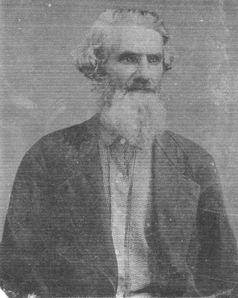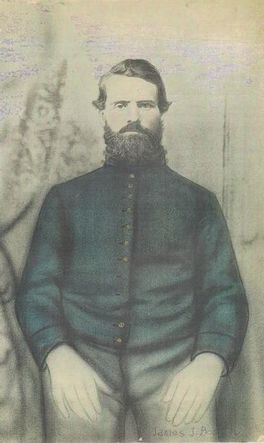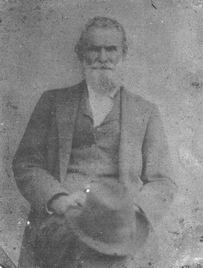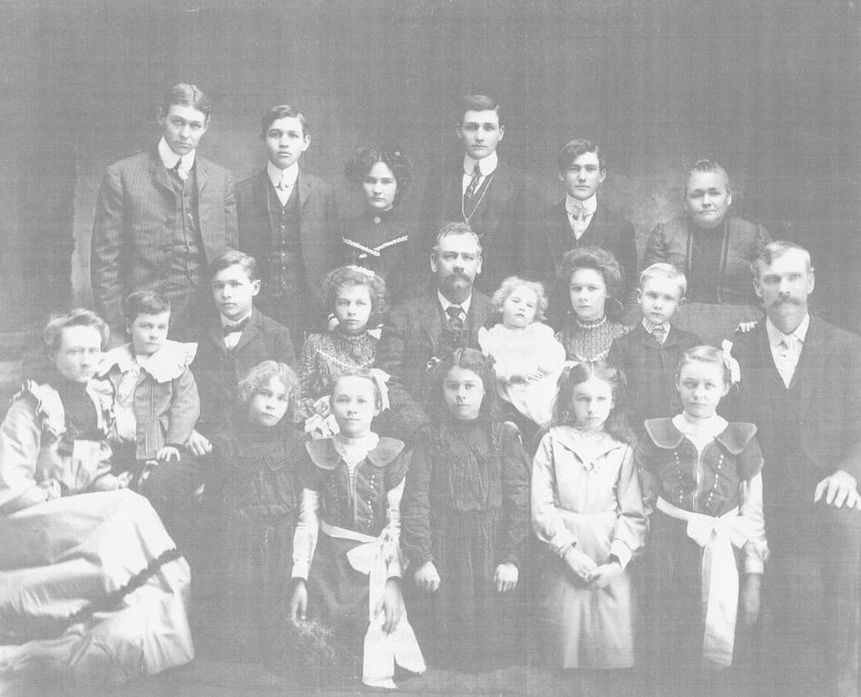 James, aged 70 years old James, aged 70 years old James Josiah Booth was the older brother of my 2nd-great-grandfather John William Booth. They were the sons of Anderson Booth and Margaret Holtzclaw. James' son, Thomas Hobbs Booth married my John's step-daughter Samella Matthews. James was born November 03, 1828 in Kentucky and died of Chronic Nephritis on August 05, 1912 in Winfield, Kansas. He was buried August 06, 1912, Union Cemetery, Winfield, Kansas. James married RUTH ANN WARD October 01, 1852 in Jefferson County, Illinois by Noah Johnston, Justice of the Peace. Ruth was born September 02, 1824 in West Virginia, and died July 15, 1911 in Winfield, Cowley County, Kansas. She is buried in Graham Cemetery. During the Civil War, James served in the 7th Regiment Company A, Illinois Cavalry Volunteers. The 7th Cavalry was organized at Camp Butler, Illinois and mustered into service on October 13, 1861. The drilling and instruction of the regiment was conducted by Lieutenant Colonel Price until the end of October when he, Major Rawalt and Companies A, C, I and G were ordered to Bird's Point to join eight other companies. They arrived on December 25, 1861. They remained there until January when they moved to Cape Girardeau where they served as scouts and gave protection to Union citizens and ran out the rebels. In the spring of 1862, they advanced to New Madrid and captured a battery of steel breech-loading guns from the famous rebel Jeff Thompson. They then operated south of New Madrid on the Mississippi River where they patrolled the batteries on the banks and the rebel fleet of six vessels, some ironclad. They remained in that location until the fall of Island No. 10. The island was named this because it was the tenth island downstream from the confluence of the Mississippi and Ohio Rivers and was at the southern end of a bend where the river turned back north. There were 4000 rebel troupes and over 100 cannons on the island. They then moved up the Tennessee River with forces under General Pope to Hamburg Landing and ultimately Corinth, Mississippi. The roads were nearly impassable so roads had to be constructed by "cordoroying." They progressed four or five miles a day until they reached Farmington, Mississippi and then Corinth. Corinth was where the north-south Gulf and Mobile Railroad intersected the east-west Charleston and Memphis Railroad. Though both the Union and Confederate armies were eager to fight each other, dysentary and disease weakened both sides due to an impure water supply. After Corinth, the regiment occupied the Memphis and Charleston Railroad from Tuscumbia to Decatur, Alabama, covering over forty miles, defending it against guerrillas until the first of December. The 7th Illinois Cavalry fought at the battle of Iuka, MS and again later Corinth on October 2, 3, and 4th. About forty men were killed, wounded, or missing. On the next November 23rd, the 7th Cav were among seven companies who fought Richardson near Summerville, and captured 70 men and two stands of colors. On December 1, the regiment was assigned to Colonel Dickey and joined his regiment at Holly Springs, MS. The Cavalry pursued the rebels under the command of Price to Coffeeville, MS where Price was stopped with severe losses. On December 21st, 500 men from the 7th Illinois and 300 from the 2nd Iowa marched from Oxford to Pontotoc, MS, to Tupelo and as far south on the Mobile and Ohio Railroad as Okalona where they destroyed stores and all the bridges. They then returned to the Tallahatchie River and on January 1st, they went to LaGrange, TN after marching over 900 miles during December and fighting with the enemy almost every day. At LaGrange the 6th and 7th Illinois were brigaded with the 2nd Iowa under Colonel B. H. Grierson. They frequently patrolled into West Tennessee, "relieving" the rebels of their horses and mules. On April 17th, the 7th Illinois and the rest of the brigade went on what is now known as "Grierson's Raid." This raid demonstrated more than any other the "dash, courage, hardihood, and power of endurance of Illinois soldiers" (Il. Mil & Naval Dept., 53). The area of the raid was in places that were almost impassable because of swamps and bayous not withstanding all the rebel troops. They were cut off from all communications with other Union regiments. They destroyed everything behind them so that retreat was impossible while they moved to Baton Rouge, Louisiana. They remained at Baton Rouge for two weeks and then joined General Augur to take Port Hudson and fought in the battle of Plain's Store. They were assigned to guard the rear against the rebels and had many skirmishes with them. After the fall of Vicksburg and Port Hudson, the 7th Illinois was ordered to Memphis by steamer and was positioned along the Memphis and Charleston Railroad. In October 1863, the regiment was at Collierville, TN and fought many skirmishes under the rebel cavalry commanded by General Chalmers. On December 26, 1863 the 7th Illinois fought against the entire force of General Nathan Forrest without any support, obviously losing to the rebels in the end. A few days later, they were fighting again at Moscow, TN. In February 1864, the 7th Illinois joined W. Sovy Smith and marched from Germantown to West Point, MS, the 7th bringing up the rear and protected the rest of the contingent from several severe assaults from the rebels. They returned to Germantown in March 1864 where 289 officers and men re-enlisted or were furloughed in April. They then fought at Guntown, MS and were defeated. When General Nathan Forrest raided Memphis, seven companies of the 7th Illinois fought against him on the Hernando road where they lost several men. They then joined the 6th Cavalry and followed General Forrest to the Tallahatchie River. On September 30, 1864, the regiment was assigned to General Hatch's Division and marched toward the Tennessee River by way of Summerville and Boliver, MS. They crossed the river at Clifton and joined an infantry commanded by General Washburne who was also in pursuit of General Forrest. General Forrest's men had crossed the river at Florence about the same time the 7th Illinois had crossed at Clifton. The 7th Illinois remained in the area of Savannah, Clifton, and Lawrenceburg until October 26th when it was ordered to Pulaski and then they marched to Shoal Creek on November 8th. They were on picket duty until the 21st, when General Hood crossed the river and went as far as Lawrenceburg where he made a short stand. On November 24th, while at Campbellsville, the division was almost surrounded by General Forrest but managed to escape to Columbia without very much trouble, they only lost 100 men. Again, the 7th Illinois covered the rear and flanks of the infantry to Franklin and engaged the rebels again at Hart's Cross Roads and several other points. At Franklin, the 7th charged a division of infantry and drove them across the Harpeth River and captured several rebels. On December 14th, the 7th engaged the rebels at Brentwood Hills. They suffered major losses, but they routed Hood's army and followed him to the Tennessee River, fighting every day until the 23rd of December when Hood crossed again at Bainbridge. During this battle, the Fifth Division captured 23 pieces of ordnance, 2,000 prisoners and a lot of small arms. January 13, 1865 they were located at Gravelly Springs, they numbered 199 officers and men, down from the 450 that had reported for duty on December 13th, one month before. They lived for ten days on parched corn. They remained there for approximately three weeks where they were "dismounted" and sent to Eastport to receive recruits. They then numbered over 1,000 men. After the rebels surrendered, the 7th Illinois was sent to Okalona, MS where they stayed until the first of July. They then moved to Decatur, Alabama, was mounted and remained there until October 20 when they marched to Nashville and mustered out of service. They received their final pay and discharge on November 17, 1865, at Camp Butler. James Josiah was officially discharged November 4, 1865 at Nashville, Tennessee. Children of JAMES BOOTH and RUTH WARD are: 1. LAURA VIRGINIA BOOTH, b. February 22, 1854, Centralia, Marion County, Illinois; d. April 01, 1930. 2. JOSEPH WARD BOOTH, b. 1856, Illinois. 3. JOHN WILLIAM BOOTH, b. 1857, Illinois. 4. THOMAS HOBBS BOOTH, b. December 05, 1861, Illinois; d. June 13, 1922, Millet, Wetaskiwin County, Alberta, Canada. He married Samella Matthews, daughter of Mary Ellen Medford Matthews Booth. 5. MARTHA ELLA BOOTH, b. December 17, 1863, Mount Vernon, Jefferson County, Illinois; d. June 20, 1957, Minneapolis, Hennipen County, Minnesota. 6. ANNA BOOTH, b. circa 1866, Illinois The Family of James Josiah Booth Top Row Left to Right: Roy James Hathaway, George Clyde Hathaway, Unknown Girl, Guy Abram Hathaway, John Claude Hathaway, Laura Virginia Booth Hathaway Middle Row Left to Right: Unknown Boy, Ernest Hathaway, Ina Hathaway, Thomas Hobbs Booth, Unknown Girl on Thomas' lap, Anna Hathaway, Robert Anderson Booth, John William Booth Front Left to Right: Samella Matthews Booth, the first 3 girls unknown, Rutha Ellen Booth, Unknown Girl Contributors: Chris Booth Bill Tuttle Dorothy Pontius
0 Comments
Leave a Reply. |
AuthorMy name is Vicky, and after researching my family history since 1999, I have found amazing stories that need to be told. I hope you enjoy them as much as I have! Archives
May 2023
Categories |





 RSS Feed
RSS Feed